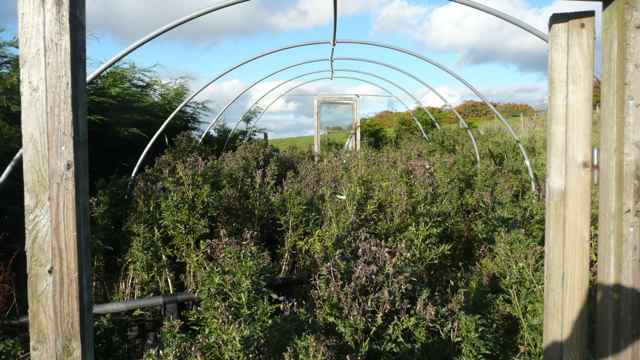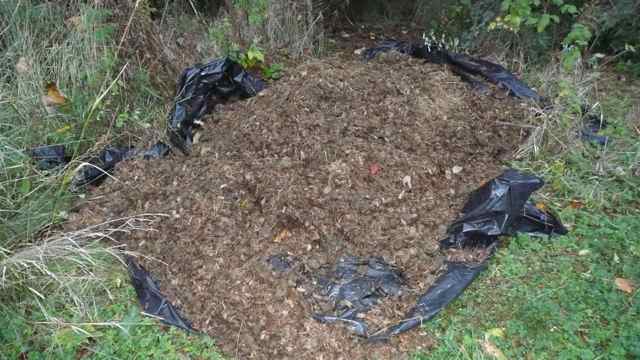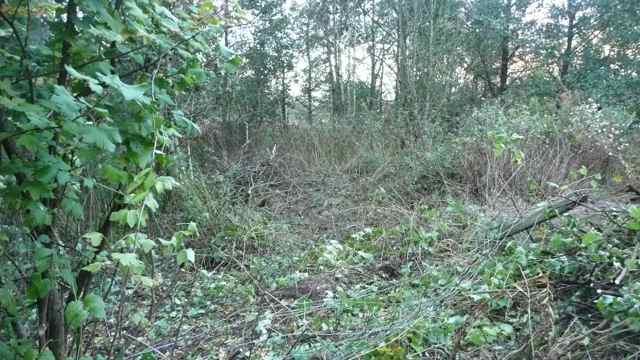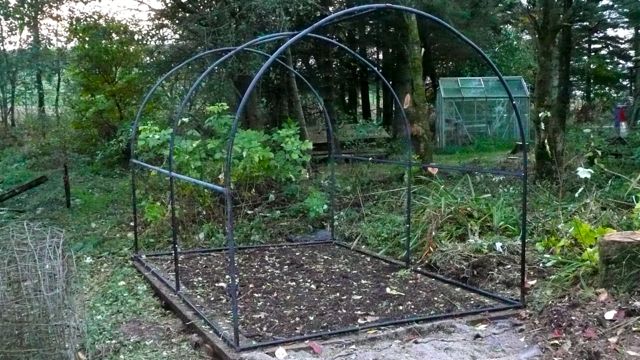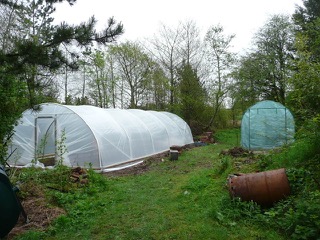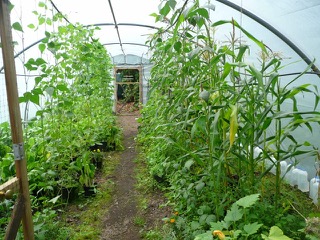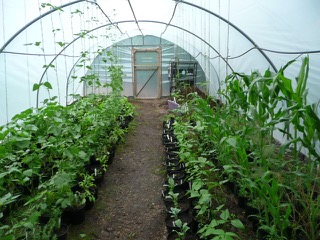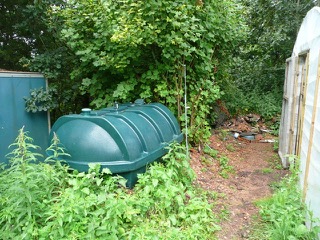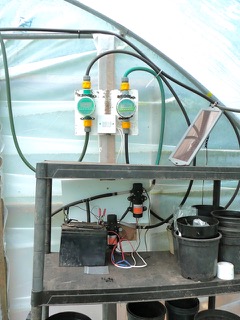The idea of a poly-tunnel was already in my head when a neighbour suggested getting one, it had probably been bobbling about for a few years but this acted as a tipping point. Other relevant factors were that the local wild bunnies keep eating our veg when they get cold, and a physical barrier might stop them. I don't like the chemicals go on the food that we import and I think there are more than enough on those we grow here, also organic is expensive……. and anyway I like making things.
Now I'm not turning into one of those 'survivalists' that you hear about, building a nuclear bunker in his back yard, but it is true that we are dependent on the whole civilisation thing continuing to function, I have always liked to have a backup, or 'plan B' in reserve and part of that is being able to do it myself. So when I saw the inactive tunnel in my travels, it all kicked off.
In one of those coincidental things that seem to happen nine times out of ten, we were given a smaller tunnel by another Jim (who usually does my proof-reading) as he felt it was the wrong shape, or colour for him. This has done very nicely as a starter lesson in controlling nature for someone who doesn't really 'garden'.
There was a large Rowan tree next to it that would have shaded it, so that had to come out. You can see the stump next to the frame. (Right) It was almost dead anyway from old age, and will burn nicely later.
A three by two metre oblong takes quite a bit of digging, mainly because I had to extract a layer of carpet that was keeping the weeds down when the Ground Source Heat Pump digger driver buried it.
The smaller one stands on the house side of the track. It has a rather smart canopy to go over the frame, green tinted and with vents and zip doors, but I'll leave that off till the weather settles
I quite like horses, but I think of them as work-mates, not pets. So I wouldn't keep any unless they were working, and anyway they are herd animals that don't appreciate solitude, which means a minimum of two and possibly foals which, while cute, magnify veterinary bills. But free horse manure? That's a useful by-product, and horse owners seem to develop in huge heaps, but have some difficulty in getting rid of. Strange really, I have seen people buy expensive compost and fertiliser in Garden Centres. Am I missing something?
I was brought up on a farm, where you don't look a gift horse in the mouth. Well it's true for the other end too, so I'll just take the waste product thanks. Fiona seems to like the idea, so I'll do the ground clearing, levelling and construction. Then when I've got it all tidy, she can grow things in it. That's gardening, I don't garden, I make things.
When I went to check out a friend's manure pile with a view to improving the ground beneath the small poly-tunnel I saw the frame in the top picture in a nearby garden. There was no cover on it and the thistles were thriving, so I guessed it wasn't being used. We had a word with the owner, and now it's ours.
Well, we owned it, the next stage was to disassemble it and bring it home. It's feet are flat plates buried a foot or so down, and there are quite a lot of them. It measures about 10.5 metres by 4 and the plastic will need replacing. Convenient really, the new generation of polythene is longer lasting and quite a bit stronger.
The new site is behind the rockery on the other side of the driveway, (well, track really), which means I can get the trailer to it. The choice of site meant a couple of trees had to come out to make way, now (not) seen on the right, and a few more on the South side because of their shadow. They will all do as firewood anyway, and I've not had to take out any of the Oak, of which I am fond. The ground needed some work though.
And so the work starts. The patch turned out to be 50% bricks, or thereabouts. I’d hoped to be able to leave the bulk well underground, but it was not to be. Having removed the volume near the surface it meant that the average ground level had fallen so far that I had to go deeper to get a reasonable soil depth, that meant extracting more bricks which in turn lowered the surface level again.
The soil from previous excavations will bring it back up, and of course there’s the manure and compost to add.
The ground had been growing trees and weeds until now, two small Rowan trees, a rather weedy Pine and a lot of Snowberry, the remainder being various grasses and quite a lot of Rosebay Willow Herb. The soil itself where it isn't brick, is shale.
Used shale that is, a rather bright pink.
Since the village was built to house the Shale miners, there is a lot of it about, and has been used to level the ground around here for years, however, it won't do for soil, so along with the brick it has to come out.
The mini-digger and operator failed to arrive (or ring back), so while waiting, I've done most of it by hand. The bricks are wet and caked in lime mortar, so I now have Popeye forearms. Several of the brick removing days were also fasting days. An odd side effect of fasting is that the fat you are burning produces a lot of water, the result is a lot of interrupting trips to the loo. It doesn't seem to have produced much of a energy shortage though, and chucking bricks about produces plenty of heat. Here's a picture of some of the bricks extracted so far.
I may have to build something with them.
Here's the part-cleared site, the white poles are about where the frame should stand. Mostly cleared now, but the heap of bricks are probably hiding more bricks and more shale. The shale is the pink stuff, it has been mined from nearby between about 1840 and 1930.
Historical note. After processing, shale is a rather tasteful shade of navy-blue but oxidises to surgical appliance pink. Oddly it is still referred to as 'Blaes' a Scottish expression meaning blue, as in Blae-berry. The bricks are pink and the traditional Lanarkshire roads are pink, but they are all quite different minerals. Pure co-incidence, especially weird as the inside of the bricks are blue too.
Scots are sometimes pink on the outside, but if you cut one in half they are (mostly) not blue, and rather annoyed, so don't.
That's the area cleared of weeds, levelled to some extent, and the frame reconstructed and level (ish). The ground has had a few cartloads of horse manure dug in. It's not very flat but we can work with that. Perhaps particularly in terms of constituent elements, I'll need some advice.
After extracting the bricks, shale and trees, we have 80% dirt, 10% sand, 5% lime, and 5% shale, to which I have added lots of horse manure, and (shortly) the product of a large compost heap. All on a field with a clay substrate which has been buried under housing for 100 years. I could do with some mineral dust, but if Vesuvius goes pop then that should arrive by air. If not, thenI was told that granite dust was the magic ingredient, and we have a quarry near-by as well, which might be the tidier option.
By the way, if you are thinking of doing this at home, there are two types of horse manure I've found so far. One has wood shavings in, bedding presumably rather than food, which appears to be a summer thing, and the other (winter) has hay. I would guess hay is better for composting, but does get tangled up in the Rotavator blades. It isn't particularly rotted, but it's getting there
The next stage is to put a door at each end, and then fit the polythene sheet, I'm glad I didn't try that last week when we had some of the highest winds on record, it is reasonably sheltered, but there are limits.
Poly-Tunnelling
1 Mostly built awaiting doors.
2 timing and pumps for sprinklers
3 Rainwater tank
4,5 Fiona's produce
1.
2.
3.
5.
4.
